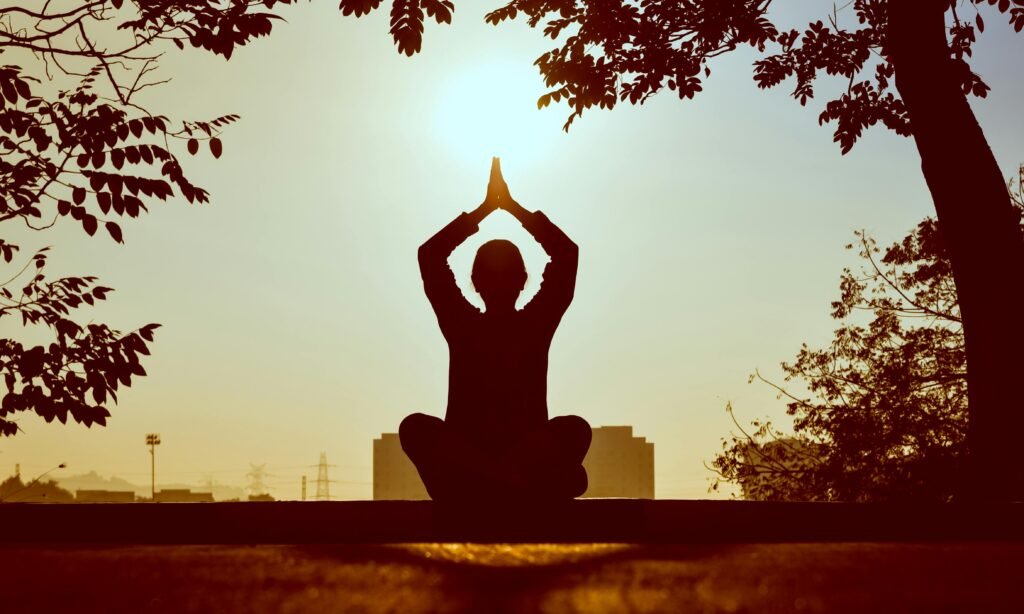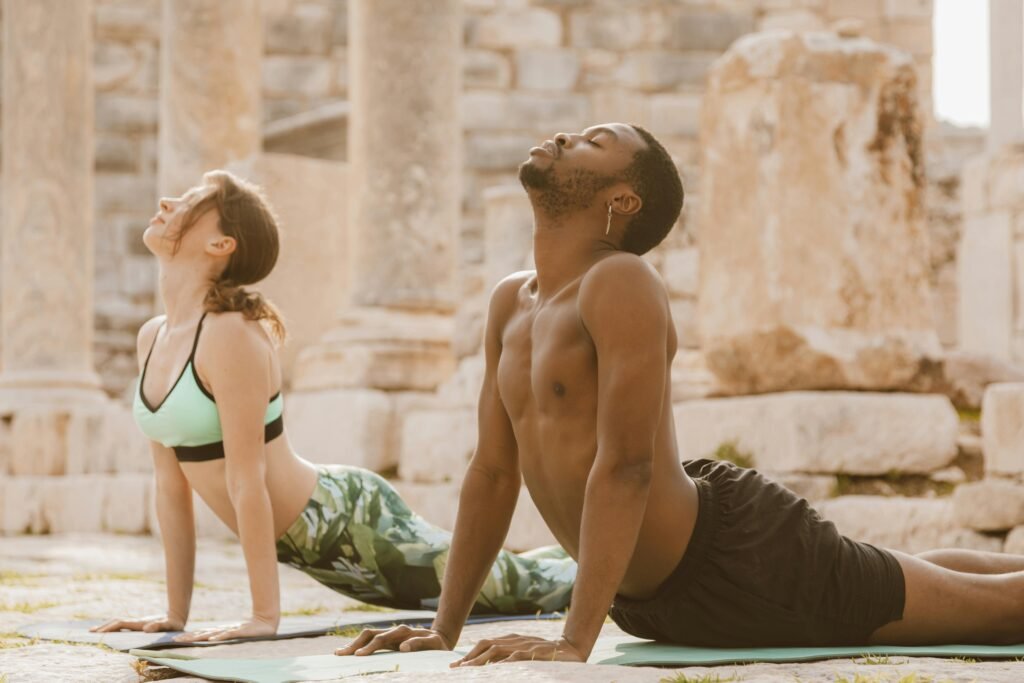Welcome, fitness enthusiasts and yoga lovers! Today, we’re diving deep into an intriguing topic: how yoga can help you build muscle. Yes, you heard that right! While yoga is often associated with flexibility, relaxation, and mental wellness, it’s also a powerful tool for muscle building. So, roll out your mats, grab a cup of your favorite herbal tea, and let’s explore this fascinating intersection of strength and serenity.

The Misconception: Yoga vs. Muscle Building
Before we delve into the specifics, let’s address a common misconception. Many people believe that yoga and muscle building are mutually exclusive. The image of serene yogis holding graceful poses often contrasts sharply with the image of bodybuilders lifting heavy weights. However, this is a misconception that we’re about to debunk.
Yoga is More Than Flexibility
Yoga is not just about flexibility and relaxation. It’s a comprehensive workout that engages multiple muscle groups, enhances endurance, and promotes strength. When practiced consistently and correctly, yoga can be as effective as traditional strength training in building muscle.
The Science Behind Muscle Building
To understand how yoga helps in muscle building, let’s first take a quick detour into the science of muscle growth.
Muscle Hypertrophy
Muscle building, or hypertrophy, occurs when muscle fibers undergo damage through physical activity. The body repairs these fibers by fusing them, which increases the mass and size of the muscles. This process requires consistent stress on the muscles, adequate nutrition, and sufficient rest.
Types of Muscle Contractions
Muscle building involves different types of muscle contractions:
- Isometric: Muscles generate force without changing length (e.g., holding a plank).
- Concentric: Muscles shorten as they generate force (e.g., lifting a weight).
- Eccentric: Muscles lengthen under tension (e.g., lowering a weight).
Yoga incorporates all these types of contractions, making it a comprehensive muscle-building practice.
How Yoga Builds Muscle
Now that we’ve covered the basics, let’s explore how yoga contributes to muscle building.
1. Engaging Multiple Muscle Groups
Many yoga poses require the engagement of multiple muscle groups simultaneously. For instance, poses like Plank, Chaturanga, and Downward Dog activate muscles in the arms, shoulders, core, and legs. This multi-muscle engagement promotes balanced muscle development and functional strength.
2. Isometric Contractions
Yoga involves holding poses for extended periods, which leads to isometric contractions. These contractions build muscle endurance and strength. For example, holding Warrior II or Chair Pose for several breaths engages the quads, glutes, and core intensely.
3. Bodyweight Resistance
Yoga uses your body weight as resistance, similar to calisthenics. Poses like Crow, Handstand, and Boat require significant upper body and core strength, stimulating muscle growth without the need for external weights.
4. Improved Muscle Recovery
Yoga enhances blood circulation, which helps in the faster delivery of nutrients to muscles and efficient removal of metabolic waste. Poses like Legs Up the Wall and Reclining Bound Angle promote relaxation and recovery, crucial for muscle growth.
5. Increased Flexibility
Enhanced flexibility from yoga reduces the risk of injuries and allows for a greater range of motion during strength training. This improved range of motion enables you to perform exercises more effectively, targeting muscles more efficiently.
6. Core Strength
A strong core is the foundation of all physical activities. Many yoga poses, such as Boat Pose, Plank, and various twists, engage the core muscles deeply, contributing to overall strength and stability.
7. Balance and Stability
Balancing poses like Tree, Eagle, and Warrior III enhance muscle stability and coordination. These poses engage stabilizer muscles, which are often neglected in traditional strength training, promoting comprehensive muscle development.

Key Yoga Poses for Muscle Building
Let’s get specific and look at some key yoga poses that are particularly effective for muscle building.
1. Plank Pose (Phalakasana)
Plank is a fundamental pose that strengthens the core, shoulders, arms, and legs. Holding Plank Pose engages multiple muscle groups, promoting endurance and strength.
2. Chaturanga Dandasana
Chaturanga is essentially a low plank that targets the triceps, shoulders, and core. It’s a challenging pose that builds upper body strength and stability.
3. Warrior Poses (Virabhadrasana I, II, III)
The Warrior series engages the legs, glutes, core, and shoulders. These poses enhance balance, flexibility, and strength, making them excellent for muscle building.
4. Chair Pose (Utkatasana)
Chair Pose is a powerful lower body strengthener. It engages the quads, glutes, hamstrings, and core, promoting muscle endurance and growth.
5. Crow Pose (Bakasana)
Crow Pose is an arm balance that requires significant upper body and core strength. It’s a fantastic pose for building shoulder, arm, and core muscles.
6. Boat Pose (Navasana)
Boat Pose intensely engages the core muscles. It’s a dynamic pose that strengthens the abs, hip flexors, and spine.
7. Bridge Pose (Setu Bandhasana)
Bridge Pose targets the glutes, hamstrings, and lower back. It’s a great pose for strengthening the posterior chain and improving spinal health.

Creating a Yoga Routine for Muscle Building
To effectively build muscle with yoga, consistency is key. Here’s a sample routine to get you started.
Warm-Up
- Cat-Cow (Marjaryasana-Bitilasana): 5 breaths
- Sun Salutations (Surya Namaskar): 3 rounds
Main Sequence
- Plank Pose: Hold for 1 minute
- Chaturanga Dandasana: 5 repetitions
- Warrior I: Hold for 5 breaths on each side
- Warrior II: Hold for 5 breaths on each side
- Warrior III: Hold for 5 breaths on each side
- Chair Pose: Hold for 1 minute
- Crow Pose: Hold for 30 seconds
- Boat Pose: Hold for 1 minute
- Bridge Pose: Hold for 1 minute
Cool Down
- Pigeon Pose (Eka Pada Rajakapotasana): Hold for 5 breaths on each side
- Legs Up the Wall (Viparita Karani): Hold for 5 minutes
- Savasana (Corpse Pose): Hold for 5-10 minutes
Integrating Yoga with Traditional Strength Training
Yoga can be seamlessly integrated with traditional strength training to create a balanced and effective workout regimen. Here’s how:
1. Yoga as a Warm-Up
Incorporate a short yoga sequence as a warm-up to improve flexibility and prepare your muscles for strength training.
2. Yoga on Rest Days
Practice yoga on rest days to enhance recovery, reduce muscle soreness, and maintain flexibility.
3. Complementary Workouts
Alternate between yoga and strength training days. For example, practice yoga on Mondays, Wednesdays, and Fridays, and strength train on Tuesdays, Thursdays, and Saturdays.
4. Post-Workout Stretch
End your strength training sessions with a yoga-based stretch routine to promote muscle recovery and flexibility.
Nutrition for Muscle Building
To maximize muscle growth from yoga, proper nutrition is essential. Here are some tips:
Protein
Consume adequate protein to support muscle repair and growth. Include sources like lean meats, eggs, dairy, legumes, and nuts.
Carbohydrates
Carbs provide energy for workouts and aid in muscle recovery. Opt for complex carbs like whole grains, fruits, and vegetables.
Healthy Fats
Healthy fats support hormone production and overall health. Include sources like avocados, nuts, seeds, and olive oil.
Hydration
Stay hydrated to maintain muscle function and recovery. Drink plenty of water throughout the day.
Supplements
Consider supplements like protein powder, BCAAs, and omega-3s to support your muscle-building goals.
Mind-Body Connection
One of the unique benefits of yoga is the emphasis on the mind-body connection. This holistic approach not only enhances physical strength but also promotes mental well-being.
Stress Reduction
Yoga reduces stress through breath control and meditation. Lower stress levels contribute to better muscle recovery and overall health.
Improved Focus
Yoga enhances focus and concentration, which can improve your performance in both yoga and strength training sessions.
Body Awareness
Yoga cultivates body awareness, helping you understand your body’s limits and potential. This awareness is crucial for preventing injuries and optimizing workouts.

Real-Life Success Stories
Let’s look at some real-life examples of individuals who have successfully built muscle through yoga.
Case Study 1: John’s Transformation
John, a 35-year-old office worker, struggled with weightlifting due to chronic shoulder pain. He started practicing yoga and noticed significant improvements in his shoulder strength and overall muscle tone. Within six months, John built noticeable muscle mass and enhanced his physical and mental well-being.
Case Study 2: Sarah’s Journey
Sarah, a 28-year-old fitness enthusiast, incorporated yoga into her routine to complement her strength training. She practiced yoga three times a week and noticed improved flexibility, reduced muscle soreness, and balanced muscle development. Sarah’s combination of yoga and strength training helped her achieve her fitness goals more effectively.
Conclusion
Yoga is a powerful and versatile practice that goes beyond flexibility and relaxation. It’s an effective tool for building muscle, enhancing strength, and promoting overall well-being. By engaging multiple muscle groups, incorporating isometric contractions, and using body.
We’d love to hear your yoga experience. Share your thoughts and experiences in the comments below! 💬




Pingback: How Yoga Changes Your Body - Fat Burn Faster 2x
Pingback: How YOGA can helps you in loosing FAT - Fat Burn Faster 2x